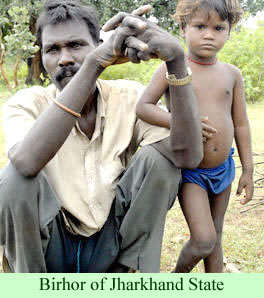The Birhor in West Bengal state experience even more poverty than the ones in Jharakhand, Orissa, and Chhattisgarh, the other states of northeastern India where they live.
 According to a report issued last week, the poverty of the Birhor in West Bengal persists despite the efforts of the state government to launch programs which could help them. Professor Sreerupa Roy, a member of the study team from the West Bengal Tribal Development Cooperative Corporation, Limited (WBTDCC), which completed the investigation, described the results for the press.
According to a report issued last week, the poverty of the Birhor in West Bengal persists despite the efforts of the state government to launch programs which could help them. Professor Sreerupa Roy, a member of the study team from the West Bengal Tribal Development Cooperative Corporation, Limited (WBTDCC), which completed the investigation, described the results for the press.
Professor Roy indicated that the government of Jharkhand State has been more successful in making the Birhor aware of development opportunities than West Bengal. He blamed the failure in West Bengal on the fact that the Birhor there have been reluctant to give up their nomadic, forest-based, lifestyle for the benefits of development.
The study team, conducting its investigation in Purulia District, West Bengal, found that the Birhor population had increased from 271 to 327 in the 20 year period 1991 to 2011. It reported that the Birhor are looked down upon by other tribal groups in the district due to the fact that, until very recently, they still subsisted on nomadic hunting and gathering.
“The forest formed an integral part of their culture and tradition,” the report stated. The news story about the study didn’t note that their name, Birhor, actually means “people of the forest.”
In 2008, when a range of hills was deforested, some Birhor were relocated to concrete, hut-shaped buildings, but they preferred to continue their nomadic lives in the remaining forests. The report indicates that they have a low life expectancy because of nutritional deficiencies and diseases. They have also begun consuming alcohol, bought in stores, as a substitute for their traditional beverage, which had much less alcoholic content. Due to deforestation, the plant they had used to make that beverage is no longer available.
The Birhor also used to fabricate ropes for sale in market towns, their primary source of income in the 1980s according to Adhikary (1984b), but the plants they formerly gathered to make the ropes are gone. The government of West Bengal indicates that their primary source of income now is from day labor.
Sudhir Dutta, Director of WBTDCC, says that NGOs and government agencies are aware of the problems the Birhor face and are trying to help. He believes that if the efforts of the different organizations were better synchronized, the Birhor might benefit.
In a separate news story last week, the Times of India reported that the students in a school in Jharkhand State decided to investigate a Birhor community in the context of the 34th National Games. The biennial sporting event, a mini-Olympics for the Subcontinent that is being held this year in Ranchi, the capital of Jharkhand, started last Saturday, February 12, and will run for two weeks.
A team of college engineering students visited the Birhor village of Chalkari and handed out pictures of the mascots for the National Games as a way of trying to develop an awareness in the village of the sporting event. The students were aware of the reputation of the Birhor as being more attuned to their natural environment than other people, so part of their reason for visiting was a hope that they might gain from them some ideas about developing a better balance with nature.
But the students were very disappointed to see abject poverty in the village, and to learn that the benefits, as they saw them, of development had not reached it. Chalkari does have a primary school, and it has been in the news for other reasons in February 2009, July 2009, and February 2010.